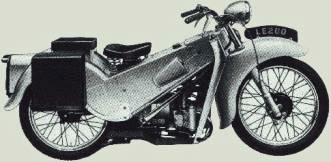In 1958 Velocette introduced the model LE Mk.III. A foot change and kick-starter were put into production after previously being a hand gear change and hand starter. It had a four-speed gearbox and a 192cc water-cooled engine, and 18" diameter. Wheels The Miller electrics was now shared with a Lucas system of 12 volts, mainly introduced for the police, as we required heavy power use, due to the introduction of radio telephones. The petrol tank capacity was 1.62 galls. The bike had now come to the end of its development and was the best of all the marks, it being a lot safer and easier to change gear by foot, with hands remaining on the handlebars at all times. The engine was strong and reliable. Windscreens were basic but had not existed prior to this model The end of production came in 1970, the year Velocette went out of business. Till then the police were the main customers. Their riders had high regard for the machines, which outlived every other type of light motorcycle the police had put into service.
Five days after starting the lightweight motorcycle course, we were allowed out of the classroom and allocated a motorcycle, but not allowed to start it. We had to push it from the garage, across Aerodrome Road, that separated the driving school garages from the now largely disused Hendon Aerodrome. This was a WW11 fighter aerodrome whose old runways were now being used mainly by the driving school to introduce students to their driving procedures. Because I was already a motorcyclist, together with about six others, we were allowed to acclimatize ourselves to riding the Velocette alone. Whilst the non-riders were instructed in the basics of not falling off by the instructors. This resulted in us “experienced” men riding like mad things up and down the runways, and resulted in several near misses.
The next day saw the start of our formal training with groups of three Velocettes under the instruction of a Sergeant instructor, who rode a large Triumph 750cc motorcycle alongside us at breakneck speeds in an attempt to keep his three charges under control. This lasted for a period of five weeks, with daily journeys taking us further away from the driving school. Various locations in the south of England were visited, apparently on the whim of the instructor. I remember well on one occasion, going to the heights of Whipsnade in Bedfordshire. The weather was terrible, with torrential rain, and I started to get problems with my engine cutting out, until just outside the Zoo it finally died. Water had somehow got into the petrol tank and there was no chance of starting the engine. It appeared that the four of us were going to have a long wait for the breakdown vehicle to come from the driving school.

